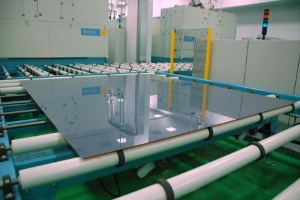Wednesday, January 21st, 2009
The first customer for an Applied Materials (AMAT) turnkey SunFab thin-film PV fab—Moser Baer in Greater Noida, India—announced today that the 40 MW capacity line has passed final acceptance test (FAT) certification after having met all manufacturing, module efficiency, and yield specifications. PV modules from the line have been certified by the International Electrotechnical Commission (IEC), verifying that they meet stringent performance and safety specifications under challenging environmental conditions.
This beta exit is a major milestone for both companies, since Moser Baer was AMAT’s first SunFab customer. The 40MW capacity line is the largest thin film solar line in India, and uses the world’s largest (2.2m x 2.6m) glass subtrates. “We are excited to see how rapidly this factory achieved 40MW capacity production with high yields—a tribute to great teamwork between the companies,” said Dr. Randhir Thakur, senior vice president and general manager, SunFab Thin Film Solar and Display Business Group at Applied Materials.
Commenting on the development, Deepak Puri, the Chairman and Managing Director of Moser Baer, said: “Moser Baer is pursuing a differentiated strategy in the high growth photovoltaic business and launching production of the SunFab thin film solar module line is of great significance in our effort to bring the solar energy dream to fruition. The thin film line will help us significantly scale up our manufacturing capacity and supply thin film solar modules to our customers. The close relationship we have with Applied has enabled us to quickly ramp up our Greater Noida facility.”
The analysts at iSupply have looked at PV supply:demand balance over the next few years, and predict that overcapacity will result in severe price competition. Vertically integrated companies (such as Moser Baer, with c-Si and CPV fabs in addition to the TF SunFab line) and the most cost-efficient cell lines (such as First Solar) should fare the best during the anticipated shake-out. Overcapacity in module production will exceed 160% in 2009 and remain above 100% through 2012, bringing silicon module prices crashing down to between US$2.50 and US$2.75 per watt. –E.K.

